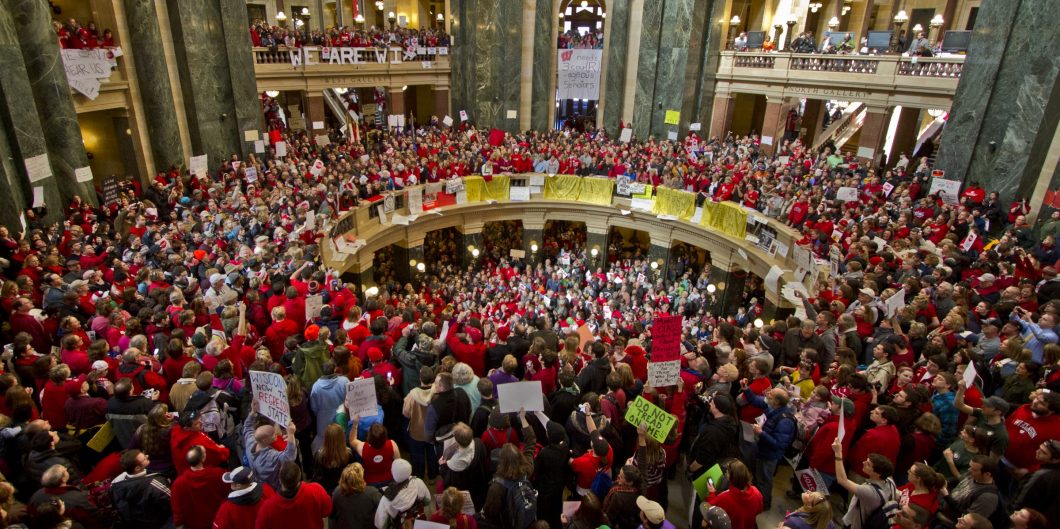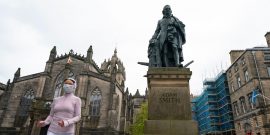How Public Sector Unions Are Complicating Our Crises
In his 19 years on the Minneapolis police force, Derek Chauvin had 18 complaints lodged against him—far more than average—before he killed George Floyd. In my home city of Chicago, the story of the most notorious police killing, that of Laquan McDonald, is similar. The police officer charged and convicted in the case, Jason Van Dyke, faced 20 complaints against him, more than 94 percent of the police force.
In both cases, a core problem was that these officers were not sufficiently disciplined to change their behavior or fired before these dreadful incidents. Police unions impose procedural requirements that make it harder for leaders of police departments to manage their subordinates to get the best out of them. It has been shown empirically, for instance, that in Florida, when law enforcement officers get collective bargaining rights, incidents of violent misconduct increase. The ultimate cost of such misconduct is not only violence to the victims, but the loss of trust in the police. Adverse public reaction, in turn, causes police to pull back from enforcement. This results in far more deaths, almost entirely among minorities and the poor, at the hands of criminals who can act with greater impunity.
Public sector unions are much more powerful than private sector unions. In the private sector, negotiations take place between owners, or their agents, and unions. Thus, the negotiations are at least two-sided. As Max Schanzenbach and I have noted, by contrast, in the public sector, the citizens of the state who pay taxes and receive public services are the stakeholders across the bargaining table from unions. But, unlike in the corporate setting, the bargaining is not two-sided: the citizen stakeholders are represented by elected officials, most of whom have received significant campaign contributions from public sector unions. In such a situation, citizens are liable to exploitation by the union and public services suffer.
Unions tend to focus on protecting their most vulnerable members, because they are the members most likely to support the union. That means compressing the wage scale, so that the least productive are better paid even if that means that some of the very productive are less well paid. It also means protecting the worst from being fired, because termination is the worst of all possible outcomes from the perspective of the union member. The union is providing a kind of insurance with procedures that make dismissal harder. And these procedures also have the advantage of being opaque to the citizenry. It is not rational for citizens to spend time understanding their complexities, given the very small chance that their vote will be decisive in eliminating them.
It might be thought that a crisis, like the current one, where there are almost daily protests of police shootings, would provide an impetus for reforming the power of police unions. Yet in Illinois, for instance, police discipline remains a subject of collective bargaining, even though it can be changed at any time by a vote of the Illinois legislature and the approval of the Governor. Given that these politicians frequently denounce police brutality, why don’t we see reform?
In pressuring jurisdictions to ban private school instruction, teachers’ unions do not let a crisis go to waste: they use it to hurt the competition.
Public sector unions are the primary reason why change does not happen. The police unions are opposed to reform and unions are a particularly powerful, concentrated interest group, able to deliver both campaign contributions and votes at election time. Nevertheless, the power of the Chicago police union is not enough to explain the inaction of the Illinois and states controlled by Democrats. Police are not a particularly strong Democratic constituency. The problem is that reforming collective bargaining for police would raise unanswerable questions about why that reform should not be extended to other public sector unions, particularly teachers’ unions, that also use collective bargaining to make it almost impossible to fire their members. Teachers’ unions are a mainstay of the Democratic Party in Illinois.
And just as police unions are exacerbating our current criminal justice crisis, teachers’ unions are worsening the coronavirus crisis by making it much harder to educate the next generation while the virus continues. Across the country, teachers’ unions are pushing to make all teaching online. Chicago’s union is again a paradigmatic example. They succeeded in switching from a hybrid schedule to a wholly online format by threatening a general strike. Teachers’ unions are also seeking to limit the hours of online teaching so that they would offer substantially fewer hours of instruction than the usual in-person class time.
Both ideas may benefit teachers, but they harm the nation’s children and do not pass a cost-benefit analysis. For younger children—those through fifth grade—online education is almost useless. Most do not have the discipline to sit by a computer, even with a parent close-by. And forcing parents to provide this discipline impedes their own work and harms the economy. Yet the costs of in-person learning for children under ten seem lower than the risks. While the science is still not entirely clear, fewer young children seem to get the virus and the ones that do rarely get seriously ill. They also spread the virus less than others. Younger children should be at school so long as appropriate precautions are taken, like requiring the wearing of masks. Even older children should get full online teaching or the funds for teacher salaries should be distributed to parents to do better for their children.
The National Education Association, the umbrella organization for primary and secondary school teachers, is an organization that professes great concern about inequality. Yet the loss of instruction in schools will hurt the poor most of all because their parents will on average be less capable of making up for it.
The effects of teachers’ unions on the virus crisis extend beyond the limitations they impose on public education. Some of the jurisdictions with the most powerful unions, like California and New Jersey (and Montgomery County until the Maryland Governor reversed the decision), have stopped private schools from offering in-person teaching, even for young children. This policy is designed to advance the interests of teachers’ unions. The ability of private schools to continue deep learning with reasonable safeguards will undermine the support for public schools. Moreover, unlike public schools, private schools depend on the willingness of parents to pay for them. Private school parents are unlikely to pay as much for online education and probably will withdraw their students from the lower grades, given the uselessness of the online option there. Thus, in pressuring jurisdictions to ban private school instruction, teachers’ unions do not let a crisis go to waste: they use it to hurt the competition.
To be sure, even without public sector police and teachers’ unions, governments would face hard choices. The disciplinary rules that would maximize sound policing and effective crime-fighting are hardly self-evident. Likewise, the Covid crisis is real and, in higher grades, may require tradeoffs between public safety and student learning. But these decisions would more likely be made in the public interest if they were not distorted by the private interests of police officers and teachers—interests whose power is magnified by public sector unions. There is much talk about privilege in the United States these days, but the special legal privileges of these unions harm everyone, especially the least well off among us.



